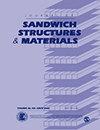纳米粘土对玄武岩-环氧面板和泡沫芯芯夹层板性能的影响
IF 2.8
3区 材料科学
Q1 ENGINEERING, MECHANICAL
引用次数: 0
摘要
据报道,泡沫夹层板的性能可以通过在面板或泡沫芯中加入纳米粘土来增强。本研究尝试将纳米粘土分散到环氧胶粘剂中,使片材与芯材粘合。该夹层板采用玄武岩/环氧复合材料作为面板,聚氯乙烯泡沫作为芯材。通过弯曲和准静态压痕试验的表征结果表明,纳米粘土的注入使岩心的弯曲强度提高了34%,抗剪强度提高了51%,吸能提高了72%。此外,纳米粘土增强夹层板的吸声系数略高于未添加纳米粘土的对照试件。从弯曲和准静态压痕试验中观察到的另一个有趣现象是,纳米粘土的加入也会影响破坏行为和受损区域的大小。优越的吸能和吸声特性使泡沫夹层板成为需要隔音的结构应用的潜在材料。本文章由计算机程序翻译,如有差异,请以英文原文为准。
The effect of nanoclay on the performance of basalt-epoxy facesheet and foam core sandwich panels
It has been reported that the properties of a foam-based sandwich panel can be enhanced by incorporating nanoclay into the facesheet or foam core. In this study, an attempt was made to disperse nanoclay into the epoxy adhesive so as to bond the facesheet with the core. The sandwich panel in this study was fabricated using a basalt/epoxy laminate as the facesheet and polyvinyl chloride foam as the core material. The characterisation results through flexural and quasi-static indentation tests revealed that the infusion of nanoclay led to an increase of up to 34% in the bending strength, 51% in the core shear strength, and 72% in energy absorption. In addition, the nanoclay-reinforced sandwich panel showed a slightly higher sound absorption coefficient than the control specimen without nanoclay. Another interesting observation from the flexural and quasi-static indentation tests was that the addition of nanoclay also influenced the failure behaviour and the size of the damaged area. The superior energy and sound absorption characteristics make the foam-based sandwich panel a potential material for structural applications requiring acoustic insulation.
求助全文
通过发布文献求助,成功后即可免费获取论文全文。
去求助
来源期刊

Journal of Sandwich Structures & Materials
工程技术-材料科学:表征与测试
CiteScore
9.60
自引率
2.60%
发文量
49
审稿时长
7 months
期刊介绍:
The Journal of Sandwich Structures and Materials is an international peer reviewed journal that provides a means of communication to fellow engineers and scientists by providing an archival record of developments in the science, technology, and professional practices of sandwich construction throughout the world. This journal is a member of the Committee on Publication Ethics (COPE).
 求助内容:
求助内容: 应助结果提醒方式:
应助结果提醒方式:


